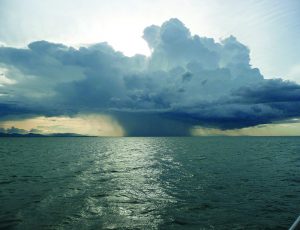AGU was established in 1919 by the National Research Council and for more than 50 years operated as an unincorporated affiliate of the National Academy of Sciences. AGU was independently incorporated in 1972.
 From its beginning in 1919 as the union of two committees—the American National Committee of the International Union of Geodesy and Geophysics and the Committee on Geophysics of the National Research Council—AGU has grown to be the preeminent international force for the promotion of geophysical endeavors. Even in the early days of small-scale geophysics, from 1919 to 1948, AGU’s annual meetings provided the chief meeting place for the world’s leading geophysicists. Since then, the breadth of the field has vastly expanded as emerging technologies have enabled us to make significant advances in our understanding of Earth and space.
From its beginning in 1919 as the union of two committees—the American National Committee of the International Union of Geodesy and Geophysics and the Committee on Geophysics of the National Research Council—AGU has grown to be the preeminent international force for the promotion of geophysical endeavors. Even in the early days of small-scale geophysics, from 1919 to 1948, AGU’s annual meetings provided the chief meeting place for the world’s leading geophysicists. Since then, the breadth of the field has vastly expanded as emerging technologies have enabled us to make significant advances in our understanding of Earth and space.
The work of AGU member scientists addresses processes that affect communities across the globe every day: rainfall rates, trends in marine fisheries, earthquake probabilities, lunar cycles, and volcanic eruption potentials. Much like the mechanisms that make our planet function, the work of geoscientists is interconnected with other research endeavors where investigators work together, unselfishly share ideas and data, and peer-review each other’s findings.
As AGU in 2019 reaches the centennial of its founding, sustainability is a growing concern for humanity. Key to ensuring a sustainable future and a healthy planet will be better understanding of the Earth and space sciences. AGU and its members continue to be lead players in this work as the natural variances of planetary systems become increasingly well understood, linkages are appreciated, and perturbations are clearly identified. Some key moments in this effort include the following:
- Inge Lehmann’s discovery of the Earth’s inner core (1930)
- The inaugural publication of the Journal of Geophysical Research (1948)
- The discovery of the Great Global Rift that runs along the Mid-Atlantic Ridge (1953)
- The discovery of the Van Allen radiation belts (1958)
- The launch of Eos—the new incarnation of the flagship publication Transactions—(1969) and the publication of Geochemistry, Geophysics, Geosystems (G3)– AGU’s first online-only journal (1990)
- The publication of Journal of Advances in Modeling Earth Systems (JAMES), AGU’s first open-access journal (2013)
- The launch of AGU’s Thriving Earth Exchange (2011)
- The appointment of Susan Trumbore, the first woman editor in chief of an AGU journal, Global Biogeochemical Cycles (2014)
The implications of geophysical research are vital in informing public policy decisions. To meet this challenge, we must strive for excellence in communicating the results of that research to policy makers and the public. AGU has been working to support this goal through its publications, including Eos, and, more recently, our efforts to help scientists be better communicators through our Sharing Science program.
There have been successes and failures, controversies and consensus, but as we look back over 100 years of accomplishments, one thing is certain: The Earth and space sciences will only increase in importance over the next 100 years.

